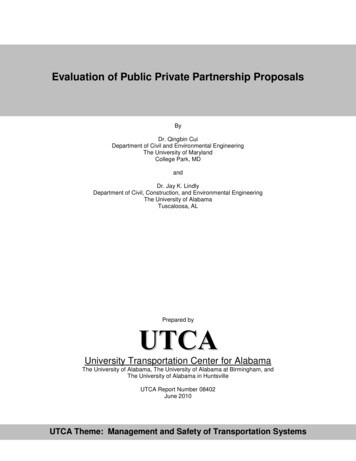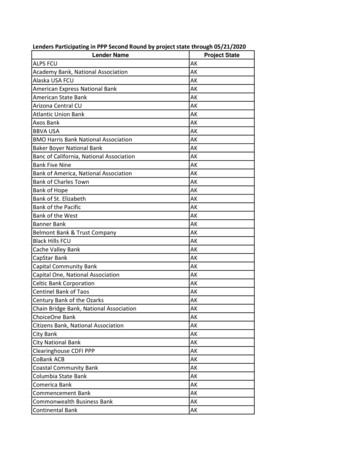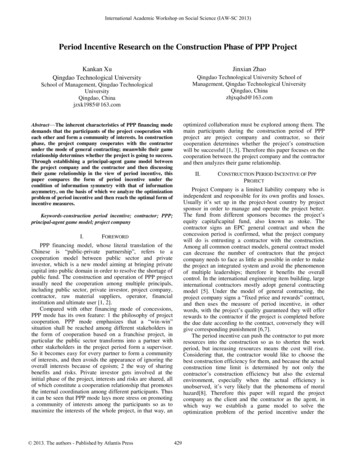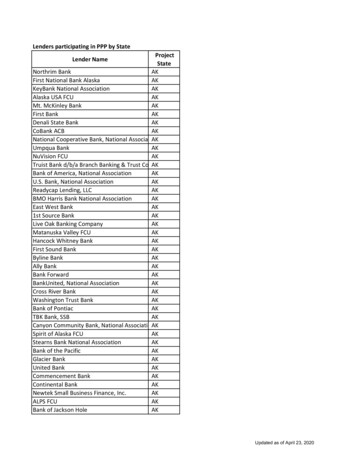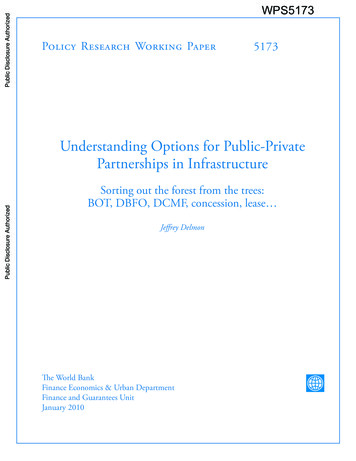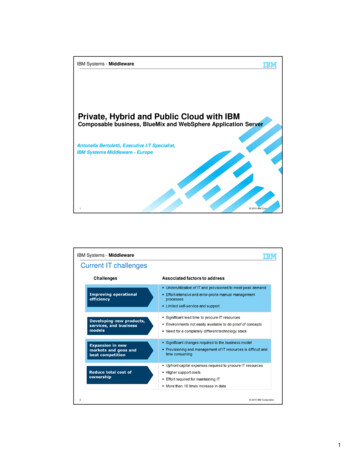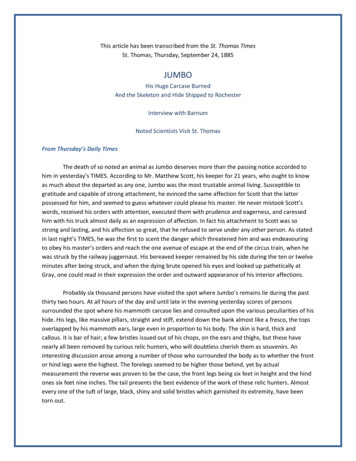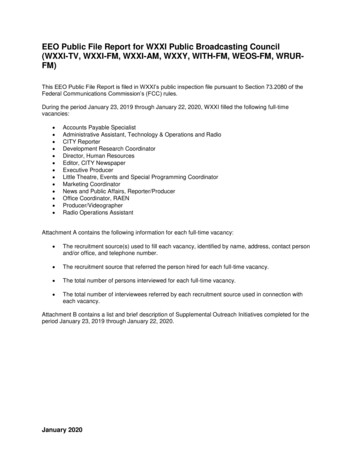
Transcription
Public-Private PartnershipHandbook
Introduction AcknowledgmentsThe Handbook was initially drafted by Klaus Felsinger, a former staff member of the AsianDevelopment Bank’s (ADB) Regional and Sustainable Development Department (RSDD),Special Initiative Group (RSOD-SI) and a member of the Innovation and Efficiency Initiative(IEI) Team, under the direct supervision of Juan Miranda, Director General of Central andWest Asia Department (CWRD) and Head of the IEI Team. Heather Skilling and KathleenBooth carried out research and compiled and elaborated on the information. The Handbookfurther benefited from relevant comments contributed by ADB staff through review ofdrafts. Elsie Araneta, Maria Anna Birken, Sally Pedersen, and Stephen Edwards providedhelpful advice and information. Ian Woodward contributed valuable information and editorialcommentary. Virginia Herrera, Majella Canzon, and Aldwin Sutarez provided their best support at the pre-publication stage. Finally, Nariman Mannapbekov of RSOD-SI painstakinglycompleted this Handbook.
Introduction Table of ContentsIntroduction1viiPublic–Private Partnerships (PPPs)—An Overview1.11.21Defining Public–Private Partnerships 1Motivation for Engaging in PPPs 31.2.1Mobilization of Private Capital 31.2.2PPP as a Tool for Greater Efficiency 31.2.3PPP as a Catalyst for Broader Sector Reform 52Recent Experience with Infrastructure Privatization and PPPs 72.1 The Level and Form of Infrastructure Privatization/PPPs from 1990–2004 72.2 Incorporating Local and Regional Investment Sources 82.3 Incorporating Social Priorities 103Structuring a PPP: Sector Diagnostic and Sector Road Map 113.1 Requirements and Expectations 113.2 Technical Issues 123.3 Legal, Regulatory, and Policy Framework 133.4 Institutional Structures and Capacity 143.5 Commercial, Financial, and Economic Issues 163.6 Stakeholder Consultation 203.7 Clear Sector Strategy and Road Map 243.8 Clear Government Commitment and a Designated Champion 264Structuring a PPP: Available PPP Options 274.1 Service Contract 294.2 Management Contracts 314.3 Affermage or Lease Contracts 334.4 Concessions 344.5 Build–Operate–Transfer and Similar Arrangements 374.6 Joint Venture 414.7 Hybrid Arrangements 4356Structuring a PPP: Selecting the Option45PPP Preparatory Work 496.1 Establishing Appropriate Legal, Regulatory, and Policy Frameworks 496.2 Technical Preparation 506.3 Institutional Structures and Capacity Building 536.3.1PPP Unit 536.3.2Project Implementation Unit 546.3.3Technical Assistance 55
6.46.56.66.7Commercial, Financial, and Economic Preparation 556.4.1Project Financing 566.4.2Tariff Design 586.4.3Tariff Adjustments 606.4.4Subsidy Design 63Labor Considerations 65Including Local Partners 66Stakeholder Involvement 677Implementing PPPs 697.1 Collecting Feedback from Potential Bidders 697.2 Notification and Prequalification 707.3 Defining the Procurement Process 727.3.1Unsolicited Proposals or Direct Negotiations 727.3.2Competitive Negotiations 737.3.3Competitive Bidding 737.47.57.67.77.88Defining the Bid Evaluation Process 757.4.1Initial Decisions 757.4.2Technical and Financial Evaluation 76Bid Package 77The Contract 78Negotiations and Contract Start 79Key Implementation Issues 80Specific Pro-Poor Activities in PPPs 818.1 Pro-Poor Characteristics of PPP Options 818.2 Pro-Poor Interventions in the Context of PPPs 828.3 Output-Based Aid Contracts 849 Framework for Measuring, Monitoring, and Reporting on Results10 Resources and Tools 9110.110.210.310.410.510.6EndnotesWebsites – General PPPs 91Websites – PPP Organizations and Units 92Websites – Sector-Specific Infrastructure 92Literature – General PPPs 93Literature – Infrastructure PPPs 93Literature – Pro-Poor PPPs 9810087
Introduction AcronymsADBAsian Development unity-based organizationIFCInternational Finance CorporationIFIinternational financial institutionLIGlow-income groupNGOnongovernment organizationOBAoutput-based aidODAofficial development assistancePIUproject implementation unitPPIAFPublic–Private Infrastructure Advisory FacilityPPPpublic–private partnershipPRCPeople’s Republic of ChinaPSPprivate sector participationNoteIn this handbook, “ ” refers to US dollars.
Introduction IntroductionThis Public–Private Partnership (PPP) Handbook is designed for the staff of the Asian Development Bank (ADB) and its developing member countries’ clients. It provides an overview ofthe role, design, structure, and execution of PPPs for infrastructure development.With inputs from policy and transaction specialists, this handbook addresses a range ofmatters associated with PPPs, from policy considerations to implementation issues. Each ofthe 10 chapters focuses on a specific area of information about PPPs: Chapter 1: introduces and defines PPPs and their context within infrastructure and development finance. Chapter 2: gives examples of evolving PPP experience within various infrastructure sectors. Chapter 3: describes the activities required to diagnose and plan for a PPP. Chapter 4: provides an overview of the major types of PPP from management and servicecontracts to concessions and build–operate–transfer arrangements. Chapter 5: examines the issues associated with choosing the appropriate PPP structurefor a project. Chapter 6: describes key tasks associated with designing and preparing a PPP projectthat will attract bidders. Chapter 7: covers the implementation of a PPP including bidder involvement and selection, the procurement process, due diligence, and contracting. Chapter 8: relates “pro-poor growth” criteria to PPP design and implementation. Chapter 9: highlights the monitoring and evaluation requirements of PPP projects. Chapter 10: includes additional resources for PPP practitioners including access pointsfor information on PPP policy, design, and implementation issues.This handbook is meant as an introduction or primer to the design and execution of PPPstrategies and projects in the context of development finance.
1 Public–Private Partnerships(PPPs)—An OverviewThis chapter introduces the concept of the public–private partnerships or PPPs, as well asits key characteristics and rationale.1.1Defining Public–Private PartnershipsThe term “public–private partnership” describes a range of possible relationships amongpublic and private entities in the context of infrastructure and other services. Other termsused for this type of activity include private sector participation (PSP) and privatization. Whilethe three terms have often been used interchangeably, there are differences: PPPs present a framework that—while engaging the private sector— acknowledge andstructure the role for government in ensuring that social obligations are met and successful sector reforms and public investments achieved.A strong PPP allocates the tasks, obligations, and risks among the public and privatepartners in an optimal way. The public partners in a PPP are government entities,including ministries, departments, municipalities, or state-owned enterprises. Theprivate partners can be local or international and may include businesses or investorswith technical or financial expertise relevant to the project. Increasingly, PPPs may alsoinclude nongovernment organizations (NGOs) and/or community-based organizations(CBOs) who represent stakeholders directly affected by the project.Effective PPPs recognize that the public and the private sectors each have certain advantages, relative to the other, in performing specific tasks. The government’s contributionto a PPP may take the form of capital for investment (available through tax revenue), atransfer of assets, or other commitments or in-kind contributions that support the partnership. The government also provides social responsibility, environmental awareness,local knowledge, and an ability to mobilize political support. The private sector’s role inthe partnership is to make use of its expertise in commerce, management, operations,and innovation to run the business efficiently. The private partner may also contributeinvestment capital depending on the form of contract.The structure of the partnership should be designed to allocate risks to the partnerswho are best able to manage those risks and thus minimize costs while improvingperformance.
Public–Private Partnership Handbook PSP is a term often used interchangeably with PPPs. However, PSP contracts transferobligations to the private sector rather than emphasizing the opportunity for partnership. In the mid to the late 1990s, there was a slowdown in public–private contractingin infrastructure sectors, which was largely precipitated by a social backlash againstthe perceived preference for the private sector over the public sector in delivering infrastructure services in developing countries. To some degree, the social backlash wasrooted in confusion between PSP and privatization. Some PSP schemes were overlyambitious and the social agenda was overlooked, leading to legitimate public concerns.The critical analysis of PSP experience has led to the design of a new generation oftransactions, which are now more commonly known as PPPs. Privatization involves the sale of shares or ownership in a company or the sale of operating assets or services owned by the public sector. Privatization is most common andmore widely accepted in sectors that are not traditionally considered public services, suchas manufacturing, construction, etc. When privatization occurs in the infrastructure orutilities sectors, it is usually accompanied by sector-specific regulatory arrangements totake account of social and policy concerns related to the sale, and continuing operationof assets used for public services.Sectors in which PPPs have been completed worldwide include: power generation and distribution,water and sanitation,refuse disposal,pipelines,hospitals,school buildings and teaching facilities,stadiums,air traffic control,prisons,railways,roads,billing and other information technology systems, andhousing.
Public–Private Partnerships (PPPs)—AnIntroductionOverview 1.2Motivation for Engaging in PPPsThe three main needs that motivate governments to enter into PPPs for infrastructure are:1.2.3.to attract private capital investment (often to either supplement public resources orrelease them for other public needs);to increase efficiency and use available resources more effectively; andto reform sectors through a reallocation of roles, incentives, and accountability.Each of these is discussed below.1.2.1Mobilization of Private CapitalGovernments face an ever-increasing need to find sufficient financing to develop and maintaininfrastructure required to support growing populations. Governments are challenged by thedemands of increasing urbanization, the rehabilitation requirements of aging infrastructure,the need to expand networks to new populations, and the goal of reaching previously unservedor underserved areas. Furthermore, infrastructure services are often provided at an operatingdeficit, which is covered only through subsidies, thus constituting an additional drain on publicresources.Combined with most governments’ limited financial capacity, these pressures drive a desire tomobilize private sector capital for infrastructure investment. Structured correctly, a PPP maybe able to mobilize previously untapped resources from the local, regional, or internationalprivate sector which is seeking investment opportunities.The goal of the private sector in entering into a PPP is to profit from its capacity and experience in managing businesses (utilities in particular). The private sector seeks compensationfor its services through fees for services rendered, resulting in an appropriate return oncapital invested.1.2.2PPP as a Tool for Greater EfficiencyThe efficient use of scarce public resources is a critical challenge for governments—and one inwhich many governments fall far short of goals. The reason is that the public sector typicallyhas few or no incentives for efficiency structured into its organization and processes and isthus poorly positioned to efficiently build and operate infrastructure. Injecting such incentives into an entrenched public sector is difficult, though not impossible, as Singapore hasdemonstrated by developing a government-wide dedication to efficiency while maintainingmany critical services within the public domain.
Public–Private Partnership HandbookIn 2005, investment commitments to private infrastructure projects in low- and middle-income countries grew by over 30% against 2004 to almost 96 billion.Figure 1: Investment Commitments in Infrastructure Projects with PrivateParticipation in Developing Countries by Sector, 1990–2005US ter019901995 2000 2001 2002 2003 2004 2005The World Bank estimates that about 70% of infrastructure investment currently comes from the public sector,8% from official development assistance, and 22% from the private sector.Source: FeatureSept2006.pdfPrivate sector operators, however, enter into an investment or contracting opportunitywith the clear goal of maximizing profits, which are generated, in large part, by increasedefficiency in investment and operations. If the PPP is structured to let the operator pursuethis goal, the efficiency of the infrastructure services will likely be enhanced. Improvingthe efficiency of services and operations also increases the chances that those services areeconomically sustainable and provided at affordable rates—even after satisfying the profitrequirements of the private operators.PPP allows the government to pass operational roles to efficient private sector operators whileretaining and improving focus on core public sector responsibilities, such as regulation andsupervision. Properly implemented, this approach s
the partnership is to make use of its expertise in commerce, management, operations, and innovation to run the business efficiently. The private partner may also contribute investment capital depending on the form of contract. The structure of the partnership should be designed to allocate risks to the partners who are best able to manage those risks and thus minimize costs while improving .
